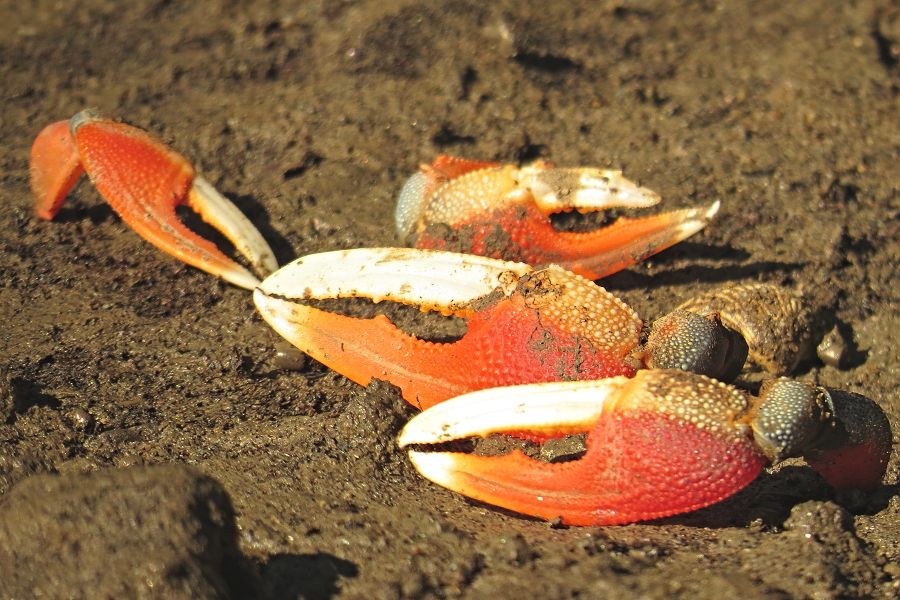The famous Cairns mudflats are almost no more. This muddiest of places and magnet
for migrating wading birds is becoming a sand flat. Some people think that the Council’s efforts
to make a sandy beach is responsible for the gradual loss of this
internationally important shorebird feeding area. Certainly the amount of sand being placed on
the esplanade should be investigated, however other factors might be at play
including cyclones and coastal processes.
 |
| Cairns' fine man made beach |
Cairns is one of a very few places where you can sit on a
boardwalk and view a dozen or more species of usually shy wild birds feeding
only metres away. The birds can’t afford
to be shy as there are few good feeding grounds in either direction. I once commissioned professional ornithologists to study one of the major
estuaries to the north of Cairns. Port Musgrave on Cape York Peninsula should be ideal
wader habitat. However we found that
when the waders are migrating, it was always high tide during the day so the waders could not feed there. It takes a special set of
circumstances to create good wader habitat.
 |
| A wading bird less than 10 m from my seat and feeding in the small remaining muddy area near the birdwatchers lookouts. |
The rich wader habitat in Cairns may also be partly of human
creation. The shape of the coastline has
been changed due to developments like the Pier and this has created a poorly
flushed area which is great for accumulating mud deposits. Long before the Pier arrived, Fogarty Park
which juts out into the estuary had been reclaimed. In the Cairns hinterland, land clearing was
at its peak and there was much less concern for soil erosion at the time. Sediment
supply from the Barron River, Trinity Inlet and even Saltwater Creek
near the airport would have been much greater. Saltwater Creek now only drains urban areas, but when I was young this
area was cane fields and would have yielded more sediment. The local Port Authority also pulls out all the
mangroves which are attempting to colonise the mudflats just off the
esplanade. This creates an open muddy
habitat in an area that would normally be a dense mangrove swamp. Harbour dredging in times past would have had
less consideration for sediment plumes and many think that these are the source
of the Cairns mudflats. Historically,
Cairns is said to have had a sandy beach. However in my imagination, the sandy beach would have risen above a
mudflat as in Cardwell today. This was the case in aerial photos from 1952.
 |
| Another wader feeding on the lumpy mud-scape near the wading pool - where the mud builds up today |
I have been trying to establish a time series photographic
record to make the changes over time visible. Unfortunately, nobody expects a fact of life such as the Cairns mudflats
to disappear, so there is not much in the way of old data. However it is obvious that at least in some
places, the mudflats are becoming sandy as you can now walk out a long way
without sinking up to your knees. The
question is where is the sand coming from and/or where is the mud going. Similar changes are also occurring at Ellie Point which extends from northern end of the Esplanade. If massive changes have been taking
place even quite far away from the sandy beach where the council dumps
sand, it suggests other factors are involved.
 |
| Dredge working in the shipping channel - note lack of life on exposed tidal flats which occupy the bottom half of the photo . |
 |
| An almost matching view from 2005. |
 |
| Telephoto view of the flats - the black object is a beer bottle (2014) |
 |
| The same area in 2005 was seething with life |
The full story is complex and I am only undertaking informal
investigations. It is probable that there is less mud coming out of the
rivers. Even the sea on the Cairns
Northern Beaches is more blue than brown these days. It used to be the colour of milk coffee in
rough weather. Sand supply has also
increased due to banning of sand mining in the Barron River and at Ellie
Point. This supply which is estimated to
be 23 000 tonnes a year is beginning to pour around the tip of Ellie Point. The
renewed supply of river sand could already be making a minor contribution to
the sand supply on the esplanade. Cyclones
may have had a bigger impact. At Cardwell, Yasi washed away vast volumes of surface mud and left only the heavier sand. Several big cyclones have passed close to
Cairns in recent years. It is the swells
that they generate that do the damage and these swells can change our coastline
even when the cyclone is hundreds of kilometres away by creating inshore
currents and by lifting sediment into the water column. Cyclones have always been around but there
has been less time between large events recently.
 |
| In 2005, seagrass beds were clearly visible from the Esplanade (the dark band). They appear to have disappeared from most of the Cairns foreshore. |
The gradual loss of large areas of mudflat from Cairns
probably has multiple causes and it would take a lot of work to apportion
blame. If you are interested in helping
to figure out what is happening leave a comment. All the photos here were taken from near Muddies Playground.


















